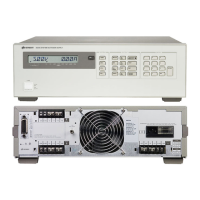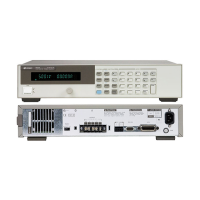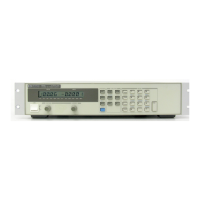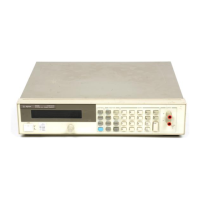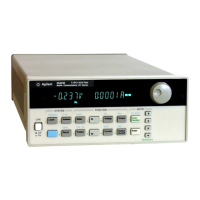b. Turn on the supply and select the output to be
tested (OUTPUT SELECT key on front panel).
c. Program the current of the selected output to 500
mA for 25 Watt outputs or 2 Amps for 50 Watt
outputs and the output voltage to 7 Volts.
d. Adjust the load until the output enters the CC
mode with the displayed output voltage slightly
less than 7 volts. The CC annuciator must be on.
e. Adjust the transformer to 13% below the nominal
voltage.
f. Wait 30 minutes for the output to stabilize under
these conditions and record the output current
(DVM reading ± 0.1 (shunt resistance)).
g. Adjust the transformer to 6% above the nominal
voltage.
h. Wait 30 minutes and record the output current. The
difference in the readings taken in steps f and h
should be less than 70
µ
A(25W) or 260
µ
A(50W).
i. Close the short switch and immediately record the
output current.
j. Wait 30 minutes and again record the output
current. The difference in the readings taken in
steps I and j should be less than 70 µA(25W) or 260
µA(50W).
k. Repeat steps a through j for each output in the
supply.
3-31 Long Term Current Drift. This test measures the
output current drift over an 8 hour period. Place the supply
to be tested in a temperature chamber or in temperature
controlled environment such as a standards room.
a. Turn off the supply and connect the output to be
tested as shown in Figure 3-3 with the DVM
connected across the + S and – S terminals, the load
switch closed, and the short switch opened.
b. Turn on the supply and select the output to be
tested (OUTPUT SELECT key on the front panel).
c. Program the selected output to 50 volts and 0.515
Amps(25W) or 1.03 Amps(50W).
d. Adjust the load for slightly less than 0.5 Amps
(25W) or 1 Amps(50W) as read on the display.
Check that the CV annunciator is on.
e. Wait 30 minutes and record the output voltage
reading on the DVM.
f. Observe and record the output voltage reading
periodically over an 8 hour period. The difference
between any two readings should not exceed 5 mV.
g. Repeat steps a through f for each output in your
supply.
3-32 Long Term Current Drift. This test measures the
output current drift over an 8 hour period. Place the supply
to be tested in a temperature chamber or in temperature
controlled environment such as a standards room.
a. Turn off the supply and connect the output to be
tested as shown in Figure 3-3 with the DVM
connected cross the current monitoring resistor, the
load switch closed, and the short switch opened.
b. Turn on the supply and select the output to be
tested (OUTPUT Select key on the front panel).
c. Program the current of the selected output to 0.5
Amps(25W) or 2 Amps(50W) and the output
voltage to 7 volts.
d. Adjust the load until the output enters the CC
mode with the displayed output voltage slightly
less than 7 volts as read on the front panel display.
Check that the CC annunciator is on.
e. Wait 30 minutes and record the output current
(DVM reading
÷
0.1 (Shunt resistance)).
f. Observe and record the output current reading
periodically over an 8 hour period. The difference
between any two readings should be less than
70
µ
A(25W) or 260
µ
A(50W).
g. Repeat steps a through f for each output in your
supply.
3-33 TEMPERATURE COEFFICIENT (TC) TESTS
These tests check temperature coefficient specifications with
the supply placed in a temperature controlled oven that
provides an even temperature distribution. The temperature
is varied over the supply's operating range and changes in
output voltage and current are measured. The supply is left
in the oven for 30 minutes to ensure stability. Note that the
test equipment, e.g. current monitor resistor, DVM, load,
etc., is located outside of the oven.
3-34 Output Voltage and Readback Voltage TC
a. Turn off the supply and connect the output to be
tested as shown in Figure 3-3 with the DVM
connected across the + S and – S terminals, the load
switch closed, and the short switch opened.
b. Turn on the supply and select the output to be
tested (OUTPUT SELECT key on the front panel).
c. Program the selected output to 50 volts and
0.515Amps(25W) or 1.03 Amps(50W).
d. Adjust the load for 0.5 Amps(25W) or 1.03
Amps(50W) as read on the display. Check that the
CV annunciator is on.
e. Set the temperature chamber to 30 degrees C and
allow 30 minutes for the output to stabilize.
f. Record the output voltage on the DVM.
g. Readback the output voltage over the GPIB and
record the value.
h. Increase the temperature to 40 degrees C and allow
30 minutes for the output to stabilize.
3-11
Artisan Scientific - Quality Instrumentation ... Guaranteed | (888) 88-SOURCE | www.artisan-scientific.com
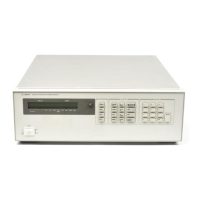
